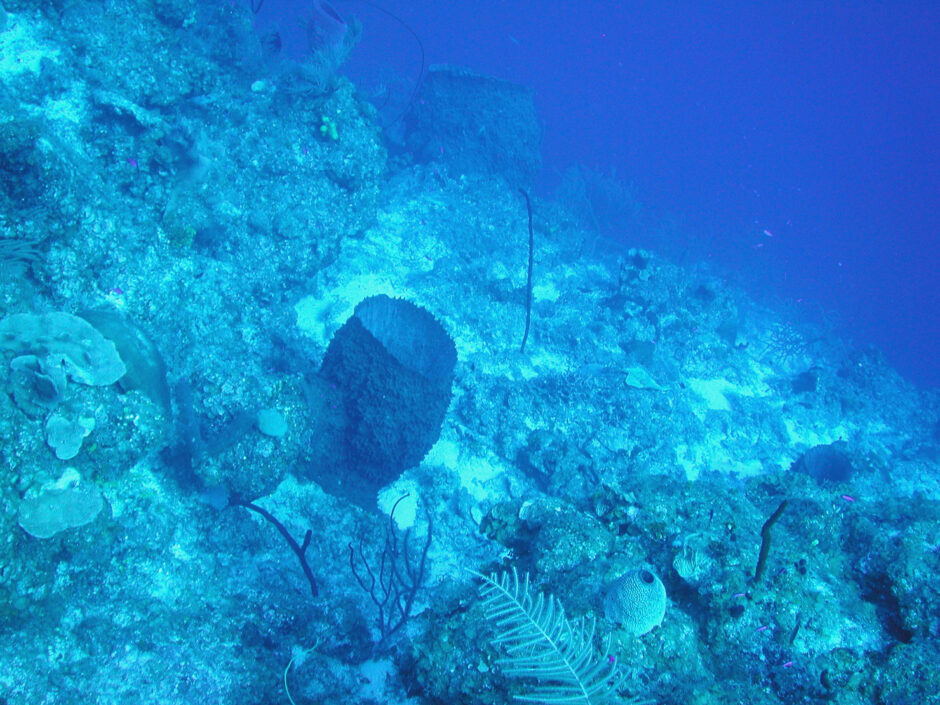Twilight Reefs and Forked Tails: How Species Adjust to the Dark
 Two big barrel sponges (Xestospongia muta) perched on a slope near a dropoff in the Cayman Islands twilight zone (Credit: NOAA-OE Twilight Zone Expedition Team 2007, Public Domain)
Two big barrel sponges (Xestospongia muta) perched on a slope near a dropoff in the Cayman Islands twilight zone (Credit: NOAA-OE Twilight Zone Expedition Team 2007, Public Domain) Though reefs may be thought of as a shallow water-exclusive habitat, reefs can be found throughout the ocean at various depths. Deep reefs, or more specifically, twilight reefs, as they have come to be commonly referred to, are reefs found in the twilight zone of the ocean. According to NOAA, the ocean is divided into three light zones, the euphotic (sunlight) zone, dysphotic (twilight) zone and finally, the aphotic zone. The zones describe the varying levels of sunlight that reach that depth. The twilight zone begins at approximately 200 meters, and photosynthesis is not possible there—which makes twilight zone reefs particularly unique.
The EPA states that most reef-building corals live in clear, shallow water that can be penetrated by sunlight, which allows the reef to grow and thrive. These reefs are critical habitats for fish and other organisms living in the environment. Twilight reefs are no different, providing complex structures for deeper-dwelling species. Despite the lack of light and impossibility of photosynthesis, LiveScience reports on a 2016 study that found these reefs are able to glean out some light energy. LiveScience reports, “The photosynthetic algae that live on and power these corals have unusual cellular ‘machinery’ that enables them to conduct photosynthesis more efficiently than species that live at shallower depths.”
On land, plants that grow in dim places develop photosynthetic antennas to capture light—however, the deep-sea algae is different. The twilight-reef algae have a modified light-gathering system compared to those observed in shallow water. The different system makes the algae more sensitive to light, allowing it to use the minuscule percentage of light that permeates past the sunlight zone. LiveScience reports that when the corals were brought to shallower waters, they were unable to survive. David Gruber, a marine biologist at the City University of New York and one of the researchers involved in the study examining twilight reefs, stated to LiveScience, “They didn’t have the ‘sunscreen’ [. . .] The light was just burning them out.”
Twilight Zone Fish
Just as twilight reefs have adjusted to the low light conditions to create a thriving ecosystem, so have the various fish species that reside there and those that migrate between depths. Researchers at James Cook University in Australia have found a simple and useful way to determine which coral reef fish species can live across the greatest range of depths, according to a release from EurekaAlert!. The key to finding the difference, they say, lies in the shape of a fish’s tail.
Specifically, the caudal fin aspect ratio, a measure of the shape of a fish tail, was found to be the best predictor of the range of reef fish species. Scientists found that fish with the greatest ranges, or those able to live in both shallow and deep reef habitats, most commonly have forked tails. Though the researchers are not yet sure why fork-tailed fish seem to have the greatest ranges, they hypothesize that the different tail shape allows them to swim more silently—a trait that is particularly important for fish to avoid detection, both for predators and prey.
Conclusion
Similar to how deep-water algae and coral have adjusted to their low light conditions, researchers continue to be fascinated by the deeper parts of the ocean as the area remains largely still unknown. Solving the evolutionary patterns of why fish have forked tails and how algae grow is just one piece of discovering more about the ocean.


0 comments